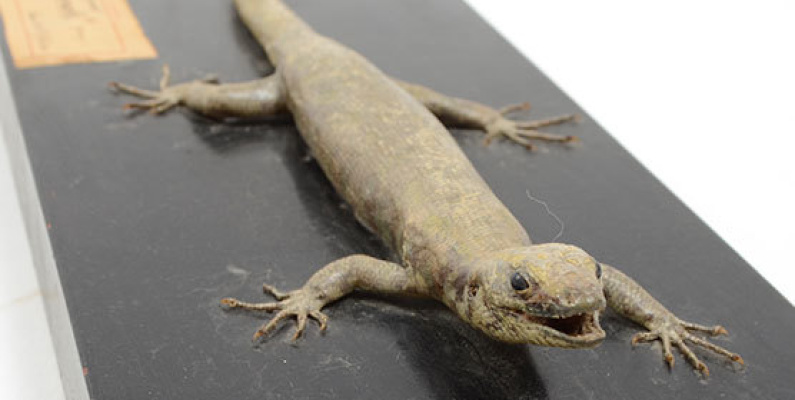
There are 63 native species of skinks and 43 native species of geckos in New Zealand [1]. Skinks have slender and smooth skin, can blink their eyes, and belong to the family Scincidae, which describes one of the most diverse groups of lizards in the world. Geckos have velvety loose skin, cannot blink their eyes, and belong to the family Diplodactylidae, which includes geckos from New Zealand, Australia, and New Caledonia. All native lizards are protected by law [2] and there are many places in Dunedin where skinks are a common sight.
In Otago Museum’s Nature galleries, the lizards of Otago are featured in a diorama to showcase the different patterns and biology of each species. Recently, the Museum received a gift of four mummified Southern grass skinks that were found under the carpet during a home renovation in Portobello. This donation contributes to Otago Museum’s collection of indigenous fauna and helps illustrate an interesting interaction between humans and native animals.

Image: Southern grass skinks (Oligosoma polychroma) found mummified under the carpet in an Otago Peninsula house. By On Lee Lau. © Otago Museum.
New Zealand’s skinks and geckos distinguish themselves from their global counterparts by giving birth to fully formed live young instead of laying eggs*. This is called viviparous reproduction and the young lizards are independent of their mother at birth. Viviparity may have evolved to provide embryos with better incubation conditions in response to cold climates and safety from predators [3]. It has been observed in many species of snakes but only a few other lizards outside New Zealand.
Most lizards live a hidden life spending the majority of their time in cracks and crevices of rocks, going into the open only to bask in the sun or forage for insects and fruits. Skinks and other lizards play an important role in controlling insect populations, pollinating native flowers while drinking nectar from them, and dispersing seeds after eating native fruits [3]. Conservation efforts have focused on creating habitat by planting native shrubs and removing pest mammals, as skinks are vulnerable to introduced mammalian predators like cats, rats and stoats [4].
If you find a sleek and shiny brown lizard in a garden around Dunedin, you are likely looking at a Southern grass skink, also called a Common skink [5]. Genetic research on New Zealand skinks has revealed that there are regional differences and undescribed taxonomic diversity in many groups of New Zealand lizards including Common skinks, Oligosoma polychroma [3]. Several new skink species have been described in the last ten years and many more lie in wait for researchers to understand the true diversity of New Zealand’s mokomoko taoka [6].
* Exception being the egg-laying skink (Oligosoma suteri)
[1] van Winkel D, Baling M, and Hitchnough R (2018). Reptile and Amphibians of New Zealand: A Field Guide. Auckland University Press, 366pp.
[2] Wildlife Act 1953.
[3] Ed Chapple D (2016). New Zealand Lizards. Switzerland: Springer Nature, 385pp.
[4] Department of Conservation.
[5] Knox C (2016). Otago Peninsula Biodiversity Group: Lizard Monitoring report. 19pp.
[6] Patterson G (2000). New Zealand National Geographic. Issue 47.
Top image: Grand skink (Oligosoma grande). Otago Museum Collection. VT2180. © Otago Museum.
